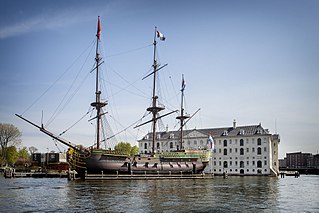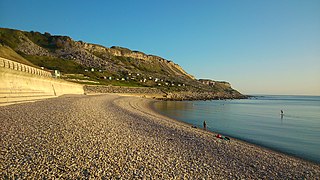
Maritime archaeology is a discipline within archaeology as a whole that specifically studies human interaction with the sea, lakes and rivers through the study of associated physical remains, be they vessels, shore-side facilities, port-related structures, cargoes, human remains and submerged landscapes. A specialty within maritime archaeology is nautical archaeology, which studies ship construction and use.

The Amsterdam was an 18th-century cargo ship of the Dutch East India Company. The ship started its maiden voyage from Texel to Batavia on 8 January 1749, but was wrecked in a storm on the English Channel on 26 January 1749. The shipwreck was discovered in 1969 in the bay of Bulverhythe, near Hastings on the English south coast, and is sometimes visible during low tides. The location in 1969 was found by Bill Young, the site agent/project manager for the sewage outfall being built by the William Press Group. With time on his hands during the long stay away from home, he followed up the rumour of the going aground. He was castigated by the Museum of London for scooping out the interior of the bow with a digger as it could have led to the structure collapsing. However, it uncovered the initial items which led to a more extensive excavation of the cargo which reflected life at the time. The wreck is a Protected Wreck managed by Historic England. Some of the findings from the site are in The Shipwreck Museum in Hastings. A replica of the ship is on display in Amsterdam.

A shipwreck is the wreckage of a ship that is located either beached on land or sunken to the bottom of a body of water. Shipwrecking may be intentional or unintentional. There were approximately three million shipwrecks worldwide as of January 1999, according to Angela Croome, a science writer and author who specialized in the history of underwater archaeology.

Chesil Cove is a curved steep bank forming the south-east end of 29-kilometre (18 mi) Chesil Beach in Dorset, England. It is thus part of one of three large shingle structures in Britain, extending from West Bay to the Isle of Portland, the latter acting more firmly as a great barrier (groyne) which stops tidal action from washing the beach away and leads to the high depositions by wind and tide action forming the grand curved bank of this "cove". The "cove", bill and much of Chesil Beach give shelter from the prevailing winds and waves for much of Weymouth Bay, the town of Weymouth and the village of Chiswell. It forms part of the Jurassic Coast.
SS Varvassi is a wrecked ship just off the Needles lighthouse, which is at the western end of the Isle of Wight. The ship crashed about 150 metres west of the lighthouse. The Isle of Wight is off the South coast of England, near Southampton.
St Anthony or Santo António was a Portuguese carrack that foundered in Gunwalloe Bay, Cornwall, in 1527 en route from Lisbon to Antwerp. She had a mixed cargo including copper and silver ingots. The wreck was recorded historically, because the salvage of the cargo was the subject of an international dispute that led to a Court of Star Chamber, but the location of the wreck was unknown until 1981. The wreck is designated under the Protection of Wrecks Act and is managed by Historic England.
class="infobox" style="width:25.5em;border-spacing:2px;"
The Wheel Wreck is the remains of a shipwreck lying in Crow sound off Little Ganinick in the Isles of Scilly. The wreck site consists of a discrete mound of cargo that appears to consist of numerous sizes of different iron wheels, cogs, clack valves, tubes and boiler pipes. Lead scupper pipes and other small artefact material show the ship was once present, however, not much remains of this vessel today. A Trotmann style anchor lies some 60m from the site, and this along with the cargo, date the site as sometime just after 1835. It has been published that this may be the wreck of the Padstow, however, being lost in 1804 this can not be so as neither boiler tubes or Trotmann anchors were invented back then. The wreck was discovered by local diver Todd Stevens in 2005 and investigated by the archaeological contractor for the Protection of Wrecks Act 1973 in 2006. It still remains unidentified. However it is most likely to be a ship called the 'Plenty' which is recorded locally as having sank- "within 1 mile of the principal island" -in 1840.
The Black Deep is in the outer Thames Estuary. It is the greatest of three mainly natural shipping channels linking the Tideway to central zones of the North Sea without shoals, the others being the Barrow Deep and Princes Channel. Between these, a few others, and the shores of Kent, Suffolk and Essex are many long shoals in the North Sea, broadly shallow enough to wreck vessels of substantial draft at low tide.

The Quanzhou Ship (泉州湾古船), or Quanzhou wreck, was a 13th-century Chinese seagoing sailing junk that sank near the city of Quanzhou in Fujian Province, and was discovered in 1973. It remains one of the most important marine archaeology finds in China, and is an important piece of physical evidence about the shipbuilding techniques of the Song China and the international maritime trade of the period.
The blockade runner Mary Bowers, Captain Jesse DeHorsey, bound from Bermuda to Charleston, South Carolina with an assorted cargo, struck the submerged wreck of the SS Georgiana in fourteen feet of water a mile off of Long Island on August 31, 1864. She "went on with such force as to make immense openings in her bottom," and she sank in a "few minutes, most of the officers and men saving only what they stood in." The steamer's passengers and crew escaped with the exception of a boy, Richard Jackson, who was left on the wreck and later taken off by the Federals.
The Kennemerland was a Dutch East Indiaman that was lost off the Out Skerries, Shetland, in 1664. It was carrying cargo from the Netherlands to the Dutch East Indies, and had taken the northern route to avoid interception by the English, since the Second Anglo-Dutch War was expected to start soon. There were just three survivors. The islanders salvaged what they could, but there were disputes over ownership of the spoil. The vessel's excavation in the 1970s was one of the earliest exercises in the new discipline of maritime archaeology.
The remains of an unknown wreck were discovered on Church Rocks, off Teignmouth in 1975. The site was designated under the Protection of Wrecks Act on 3 August 1977. The wreck is a Protected Wreck managed by Historic England.
The Chesil Beach cannon consists of the remains of an unknown wreck were found on Chesil Beach, Dorset, England in 2010. The site was designated on 18 July 2017. The wreck is a Protected Wreck managed by Historic England.
The remains of a seventeenth century cargo vessel were found to the west of the Outer Pollock Reef, off West Bay, Dorset, England in 2004. The site was designated under the Protection of Wrecks Act on 17 July 2005. The wreck is a Protected Wreck managed by Historic England.
The remains of a Middle Bronze Age vessel were identified in Langdon Bay, Kent, England in 1974. The site was designated under the Protection of Wrecks Act on 25 May 1978. The wreck is a Protected Wreck managed by Historic England.

The Rill Cove Wreck is an underwater wreck of a 16th-century Spanish cargo ship lying off the coast of Rill Cove, west of Kynance Cove, in Cornwall, England, UK.
The remains of an armed cargo vessel were discovered in 1983 in Studland Bay, off Dorset, England. The site was designated under the Protection of Wrecks Act on 22 October 1984. The wreck is a Protected Wreck managed by Historic England





